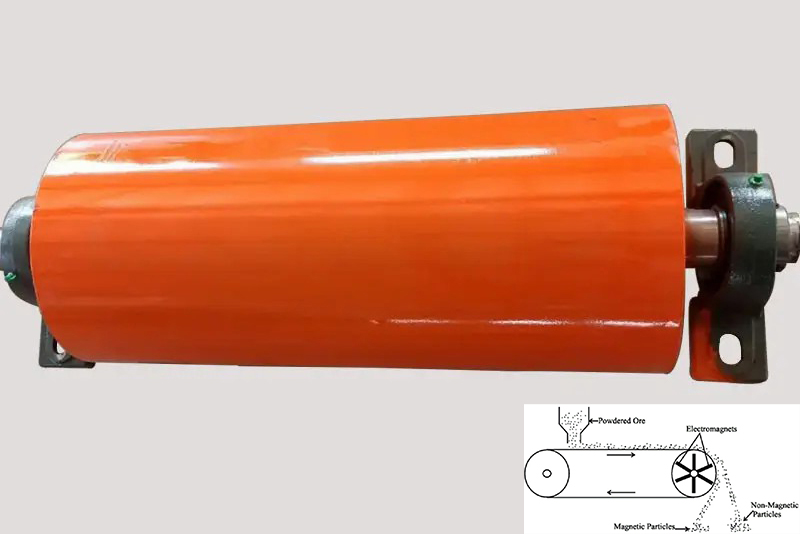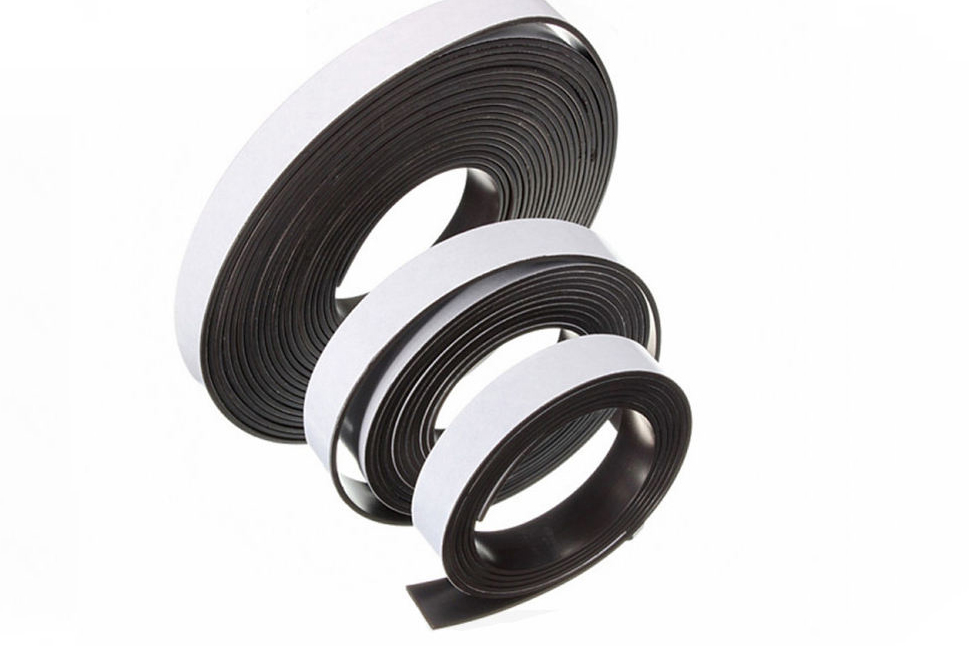A Complete Guide to Magnetic Pulley Separator
Magnetic separation is one of the most reliable and widely used techniques for removing ferrous contaminants from bulk materials. Among various magnetic separation devices, the magnetic pulley separator stands out for its simple integration with conveyor systems and continuous, automatic operation. Let’s learn about how magnetic separation works, the equipment involved, and the unique role of magnetic pulley separators in modern industry.

[1]
What Is Magnetic Separation?
Magnetic separation is a process that uses magnetic fields to separate magnetic materials from non-magnetic ones. The principle is straightforward: when a mixture of materials passes through a magnetic field, the magnetic particles are attracted to the magnet while non-magnetic materials continue unaffected.
This method is commonly used to remove ferrous impurities such as nails, bolts, or steel fragments from raw materials like grain, plastic, ore, or glass. It can also be applied in recycling to recover valuable metals or in the mining sector to concentrate magnetic ores like magnetite (Fe₃O₄).
Magnetic separation is favored for its energy efficiency, low maintenance requirements, and ability to operate continuously without manual intervention. According to industry data, magnetic separation systems can remove over 99% of ferrous contamination when properly designed and maintained.
Types of Magnetic Separation Equipment
Magnetic separation equipment varies depending on the process requirements—such as feed size, magnetic sensitivity, and installation point. The main types include:
- Magnetic Drum Separators – Cylindrical drums that continuously attract and remove ferrous particles from bulk flows. Common in recycling and heavy-duty industrial processes.
- Magnetic Grates and Grids – Used inside hoppers or ducts to capture fine metal fragments from powders and granules.
- Overband Magnetic Separators – Suspended magnets positioned above conveyor belts to remove tramp metal from the product stream.
- Magnetic Roll Separators – High-intensity devices used for separating weakly magnetic minerals such as ilmenite or garnet.
- Magnetic Pulley Separators – Installed at the head or tail of a conveyor to continuously extract ferrous materials as the material discharges.
Each type has its own advantages, but magnetic pulleys are particularly valued for their simplicity and ability to retrofit into existing conveyor systems.
5 Examples of Magnetic Separation Equipment
To illustrate their versatility, here are five common examples of magnetic separators in use today:
- Recycling Plants: Overband magnets and magnetic pulleys remove nails, screws, and iron pieces from crushed concrete or shredded plastic before further sorting.
- Mining Operations: Magnetic drums and rolls recover magnetite from taconite ores, boosting mineral purity before flotation stages.
- Food Industry: Grate magnets and plate separators remove fine ferrous dust from flour, sugar, or cereal lines to meet food safety standards.
- Ceramics and Glass Manufacturing: High-intensity magnetic filters eliminate metallic impurities that could cause defects in glazing or surface quality.
- Pharmaceutical Production: Drawer magnets capture trace metal contamination, ensuring compliance with FDA and GMP regulations.
In each case, the choice of magnetic separator depends on the level of magnetic contamination, the process flow, and the material’s physical characteristics.
What Are Magnetic Pulley Separators?
A magnetic pulley separator is a type of magnetic separator installed at the head (discharge end) of a conveyor belt. It replaces a standard pulley and uses a built-in permanent magnet or electromagnet to continuously remove ferrous contaminants from conveyed materials.
As the belt carries material toward the pulley, non-magnetic particles discharge freely, while magnetic particles cling to the surface of the pulley until they drop off underneath—separated from the main material stream. This simple mechanism allows 24/7 automatic separation without interrupting production flow.
Magnetic pulleys are typically constructed using stainless steel shells, neodymium (NdFeB) or ferrite magnets, and non-magnetic shafts to ensure durability and magnetic efficiency. They are available in sizes ranging from 150 mm to 1200 mm in diameter, making them suitable for both small-scale and heavy industrial applications.
Classification of Magnetic Pulley Separator
Magnetic pulley separators can be classified based on several factors:
- By Magnetic Source:
- Permanent Magnetic Pulley – Uses ferrite or rare-earth magnets; ideal for low-maintenance and energy-free operation.
- Electromagnetic Pulley – Equipped with an electric coil; allows adjustable magnetic intensity and is suitable for variable conditions.
- By Magnetic Strength:
- Low-Intensity Pulleys (up to 2000 Gauss) – Suitable for coarse ferrous contaminants.
- High-Intensity Pulleys (up to 12,000 Gauss) – Used for fine ferrous particles or weakly magnetic materials.
- By Application Type:
- Head Pulley Separator – Most common; installed at the discharge end.
- Tail Pulley Separator – Used for secondary cleanup or additional recovery stages.
For instance, a recycling facility processing shredded aluminum cans may use a high-intensity rare-earth magnetic pulley to remove fine steel caps or wires, achieving a cleaner aluminum fraction and reducing downstream equipment wear.
Applications of Magnetic Pulley Separator
Magnetic pulley separators are used across a range of industries where metal contamination poses safety, quality, or efficiency risks:
- Recycling Industry: Used to recover ferrous metals from municipal solid waste, plastic granules, and crushed electronic components. A case from the UK reported a 30% increase in ferrous metal recovery after replacing a standard head pulley with a rare-earth magnetic pulley.
- Mining and Quarrying: Helps separate tramp iron from crushed ore, preventing damage to crushers and grinders.
- Food and Agriculture: Removes metal fragments from grains and seeds before packaging.
- Wood and Paper Processing: Extracts nails and staples from reclaimed wood before chipping or pulping.
- Rubber and Plastics: Ensures metal-free materials for high-precision molding processes.
Because magnetic pulleys are compact, energy-efficient, and easy to retrofit, they have become a preferred choice in upgrading conventional conveyor systems for automatic separation. Modern designs also feature adjustable magnetic zones and stainless housings that can withstand abrasive materials.
Conclusion
The magnetic pulley separator represents one of the most practical and efficient solutions for continuous ferrous metal removal in bulk material handling. It combines simplicity, durability, and versatility—making it an essential component in recycling, mining, food processing, and other industries.
With growing emphasis on product purity and equipment protection, the demand for advanced magnetic separation systems continues to rise. Whether for recovering valuable metals or maintaining operational safety, magnetic pulleys remain a cornerstone technology in the broader field of magnetic separation—quietly doing the heavy lifting behind modern material processing efficiency.
Reference:
[1] Behera, Ajit & Mohapatra, Soumya. (2018). Challenges in Recovery of Valuable and Hazardous Elements from Bulk Fly Ash and Options for Increasing Fly Ash Utilization. 10.5772/intechopen.69469.















